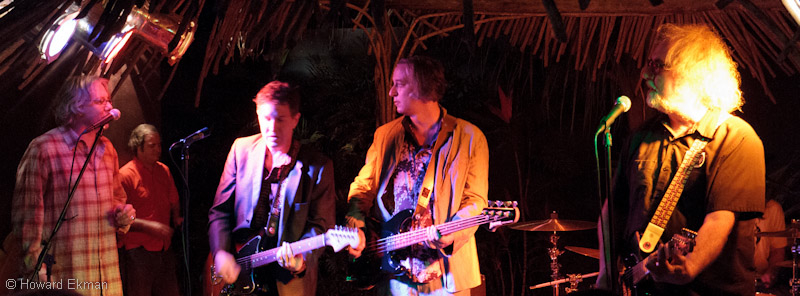Festival Founder and former R.E.M. guitarist Peter Buck has announced the talent lineup for the second annual Todos Santos Music Festival, a ten-day music event benefiting the Palapa Society of Todos Santos, A.C. The festival, presented by The Hotel California, will be held in Todos Santos, January 10-26, 2013.
The Todos Santos Music Festival will feature ten full nights of entertainment throughout the town, including eight days of music on the patio of Hotel California, a special Alejandro Escovedo concert in the town plaza, and a large concert on the beach at Punta Lobos.
The lineup of artists, hand-selected by Peter Buck, features an eclectic array of musicians ranging from industry legends to emerging local talent. The first wave of confirmed acts includes the return of: English legend Robyn Hitchcock, rock industry super group Steve Wynn and the Baseball Project, and American rock band Scott McCaughey’s The Minus 5. The roster will also include performances by revered singer-songwriter Alejandro Escovedo, 90’s alt-rock darlings The Posies, indie rock artist Joseph Arthur, Chuck Prophet’s Mission Express, and breakout Mexican indie-pop group Torreblanca. The Elected, Kev’n Kinney, Jon Langford, and Ken Stringfellow will also appear, with set times to be revealed in advance of the festival.
“This festival is the most fun I have ever had playing music with the chance to perform at an amazing location with some of my favorite musicians,” says Buck. “It is an incredibly entertaining way to raise funds that give local children more educational opportunities and share a diversity of musical talent.”

Bill Rieflin, Peter Buck, Steve Wynn, Scott McCaughey and Robyn Hitchcock at the Palapa Society of Todos Santos
The Todos Santos Music Festival celebrates the rich creative culture of the town of Todos Santos, and aims to make a difference in the community by fundraising for important local causes. This year’s festival will benefit The Palapa Society of Todos Santos A.C., which provides educational after-school programs for local children.
Tickets for all Todos Santos Music Festival events will be available for purchase on October 15th via todossantosmusicfestival.com. Detailed ticket info below:
CONCERT SCHEDULE AND TICKETING OPTIONS
HOTEL CALIFORNIA: ($2 General Admission or $15 VIP Seating)
January 10-12: Robyn Hitchcock & The Venus 3 and The Minus 5
January 17, 18, 20: The Posies and The Baseball Project
January 24, 25: Alejandro Escovedo and Joseph Arthur
PUNTA LOBOS BEACH: (Free Admission or $75 VIP/Side Stage Tickets which include: complimentary buffet, beer and margaritas; cash bar for top shelf liquor; private tented areas and restrooms as well as expedited shuttle service)
January 19: The Posies and The Baseball Project
TODOS SANTOS TOWN PLAZA: (Free Admission; $15 Reserved Bleacher Seating with table service; $60 VIP/Side Stage Tickets which include: complimentary buffet, beer and margaritas, and cash bar for top shelf liquor)
January 26: Alejandro Escovedo & The Sensitive Boys, Joseph Arthur,
Torreblanca and Chuck Prophet & Mission Express
For further festival information and reserved seating tickets, visit www.todossantosmusicfestival.com or http://festivaldemusicatodossantos.com.mx.
Journal del Pacifico is proud to be a sponsor and organizer of this event. For more on last year’s festival, see our featured stories here:
http://journaldelpacifico.com/blog/festivals/music-festival/
To keep up on all the latest, “like” the Todos Santos Music Festival on Facebook at:
https://www.facebook.com/TodosSantosMusicFestival
Additional Press
Paste Magazine: http://www.pastemagazine.com/articles/2012/09/peter-buck-announces-lineup-for-todos-santos-music.html
Pollstar: http://www.pollstar.com/news_article.aspx?ID=802761
Jam Base: http://www.jambase.com/Articles/97826/REM%27s-Peter-Buck-ProducesHeadlines-Todos-Santos-Fest
Slicing up Eyeballs: http://www.slicingupeyeballs.com/2012/09/19/peter-buck-solo-album-vinyl-only/
Athens Music Junkie: http://www.athensmusicjunkie.com/2012/09/catching-up-with-rem-again.html
La Estancia Vacations: http://blog.laestanciavacations.com/events/p1535/
Spanish
Sopitas.com: http://www.sopitas.com/site/178903-conoce-los-detalles-del-festival-todos-santos-en-baja-california-curado-por-peter-buck-de-r-e-m/
Me Hace Ruido: http://www.mehaceruido.com/2012/09/todos-santos-music-festival-hotel-california-peter-buck-rem/





